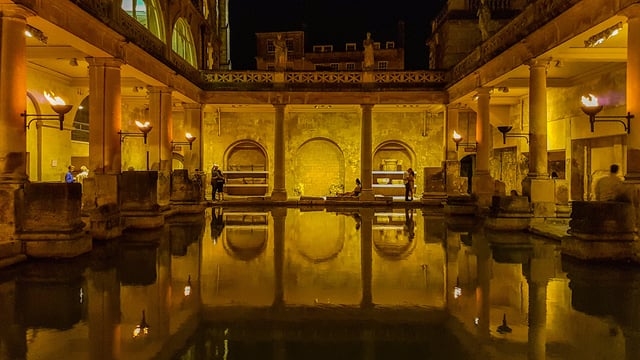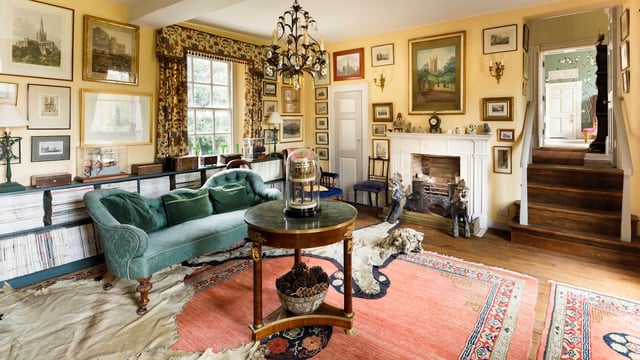In 2023, Historic England added 227 new places to the National Heritage List for England. A further 231 places had their listings amended. These range from an Iron Age Fogou in Cornwall to many exceptional examples of 20th century architecture. Originated in 1882, ‘the List’ now includes over 400,000 entries. These include buildings, scheduled monuments, registered parks and gardens, registered battlefields and protected shipwreck sites. To showcase the diversity of historic sites and places in England, I highlight 15 of the recently listed places.
- Thomas Dowson
- Last Checked and/or Updated 13 December 2023
- No Comments
- England Travel Ideas, News
Historic England, more officially known as the Historic Buildings and Monuments Commission for England, is a public body that works with communities and specialists to protect England’s historic environment. One of the ways this is achieved is through a designation system, the so-called National Heritage List for England. Each year more historic places are identified and added to the list. These places include anything from prehistoric sites to 20th century office blocks – places that each in their own specific ways goes towards defining England’s historic environment.
In 2023 there were 227 new entries to the List. These include 205 buildings or structures, 17 scheduled monuments (1 of which is a shipwreck site) and 5 new parks and gardens. Besides new additions to the list each year, places already on the List can also have its listing amended. Northwold Manor is one such property. Originally identified for protection in 1951 – but only for its exterior, the designation was amended in 2023 to take into account the architectural significance of the interior of the house. In all, there were 239 amendments to already designated places in 2023.

15 New Additions to the National Heritage List for England in 2023
The following list is a selection of some of the interesting sites added to the List in 2023. Those on this list are no more deserving or significant than the others; the selection shows the incredible diversity of places in the nation’s historic environment. The full list of over 400,000 places is publicly available and can be searched online.
Please note, not all places added to the List are accessible to the public. Given Historic England’s remit, listed sites may still be in private ownership.
Barkway Carriage Wash
During the heyday of the coaching era Barkway was an important stop between London and Cambridge. Along Church Lane is the carriage wash, built in 1600 to clean the wheels and name plates of coaches, as well as soaking the wheels to ensure the wood did not dry out and shrink. Water enters the brick-lined structure from an underground channel. It ceased to be used when motors replaces coaches, and is one of only four such structures known in England.

Cavendish Community Primary School
Built in 1904 in a Jacobean revival style, this primary school boasts architectural charm with terracotta decoration. The forward-thinking education committee planned for a detached block for teaching cookery and manual crafts, shared by other schools, while the school’s design enabled easy expansion. Original features such as glazed timber partitions and doors, fireplaces, a real slate blackboard, and a service lift remain intact, along with original parquet flooring and wall tiling. The halls on each floor are the real highlights, adorned with attractive green and yellow Art Nouveau flower-pattern tiling, and remarkable fireplaces at each end, complete with their original grates.

Chain Home Low Radar Station
Built in 1941, this World War II radar station remains largely intact, with two principal buildings and original room fittings, which include a generator bed, cable ducts and evidence of power transmission. The good condition of the facility shows how it functioned as a small, low cover coastal radar station designed to provide early warning of German aerial attacks. The station played a crucial role in the air defence of the country during the Battle of Britain and changing the course of the Second World War.

Church of St Nicholas
St Nicholas Church in Fleetwood was designed by Lawrence King, a prominent post-war ecclesiastical architect. Built in the style of an upturned boat. This design choice is in keeping with the church’s dedication to St Nicholas, the patron saint of sailors, and Fleetwood’s maritime heritage. Inside, the interior resembles the ribcage of a ship, complete with red and green navigation lights echoing the port and starboard markings. Original fixtures and fittings, including beautifully carved statues of the Virgin Mary and St Nicholas, add to the church’s charm.

Clubhouse, Beaconsfield Golf Club
Built between 1913 and 1914, Beaconsfield clubhouse is a rare and largely intact example of a purpose-built Arts and Crafts clubhouse from the first great period of golf course expansion in England between 1890 and 1914. It was designed by Stanley Hinge Hamp, a notable commercial architect of the late 19th and early 20th centuries. The clubhouse is of high quality architecturally and the interior demonstrates impressive craftsmanship in the brickwork as well as rich and elaborate decoration and fittings.

Deep Pit Railway Footbridge
This unusually long, single-span, wrought-iron pedestrian railway footbridge dates from 1887. It was built during the peak period of railway bridge construction and spanned nine tracks of the Liverpool Bury Railway line. The bridge serves a footpath which in the 1840s linked various local coal mines. Rather than steps leading up to it, the south side of the bridge has an unusual large ramp. It has survived with very little alteration and its architectural interest lies in its elegant design.

Former Liverpool Furnishing Company Showroom
This Edwardian Baroque furniture showroom was built in 1899 for the successful Liverpool Furnishing Company run by Jacob Lipson. Its flamboyant façade, adorned with embellished windows, decorated terracotta and a landmark clock tower, still bears the ghost of its painted lettering ‘THE LIVERPOOL FURNISHING CO’, more than 100 years after the company’s closure and the building’s conversion into offices. Lipson, a prominent figure in the local Jewish community after emigrating from Poland, served as president of the New Hebrew Congregation and frequented the Hope Place synagogue. To commemorate the showroom’s grand opening, a Jewish blessing and a banquet were held in the basement.

Lower Boscaswell Fogou
This fogou, a name derived from the Cornish for cave, is one of only 15 such structures to have survived in England. And all are in Cornwall. They are Iron Age in origin (500 to 200 BC) but are known to have been in use into the Roman period. This example was first recorded in 1842, and was excavated in the 1950s and 198os, only the second to have been excavated. The fogou is built into a thick dry-stone wall field boundary on its eastern side, approximately 2m high and 2m wide.

Mickling Barf House, Grimsby
A family home listed for architectural and historical interest. The single-story house was designed by husband and wife architects, Rex and Jenifer Critchlow, in three phases between 1962 and 1983 for their own use. The modern design is influenced by a range of sources, using simple materials such as timber and brick. The house displays a strong attention to detail throughout, including the inbuilt fittings. This is a private home and not open to the public.

Northwold Manor
Situated on the High Street of the medieval village of Northwold, is a manor house that was once owned by the Carter family – relatives of the British archaeologist and Egyptologist Howard Carter. The oldest part dates back to the 16th century, and there have been extensions and alterations to both the exterior and interior since. Originally listed in 1951 for its architectural significance, a more recent study following extensive sensitive renovation of the house has noted the architectural significance of the interior.

Swanwick Common Colliery
Coal has been mined in the are since the 13th century. The Swanwick Common Colliery headstock and winding house are the only structures that remain from a small early 20th century colliery. This type of coal mine was once common, but they little known. Remains of collier structures are rare, but such small-scale collieries are particularly rare, and they are vulnerable to destruction and removal. Extraction of coal probably ceased in the mid 20th century.

Swingate Water Tower
Constructed in the immediate post-war period by Ritchie and Partners, this reinforced concrete Water Tower was built alongside a large, new covered reservoir to provide a more reliable supply of drinking water for Nottingham. It is unusual because of its neo-Georgian style with a surprising degree of architectural embellishment for a building of this type and date. The addition of long strip windows to the access tower adds to the impression of its height. It contrasts with most post-war water towers, which tended to be utilitarian structures made out of reinforced concrete and designed primarily for practical purposes.

The Dome, Doncaster Leisure Park
Doncaster’s landmark leisure centre, the Dome is a good example of Post-Modernist and High Tech architecture. When it opened in 1989 it was the largest leisure centre in Europe attracting over a million visitors a year and winning many awards. Its design, with a central atrium, multiple pools, ice rink, sports halls and squash courts, was meant to be a place of pleasure and fun, not only for serious sport. The indoor pool leads into a heated outdoor pool, which was one of its kind in the United Kingdom.

The Light House
Built between 1984 and 1985 the Light House was designed by the architect Ivan Simovic as a family home. And continues to be a private residence. The building is a good example of the way Post-Modern ideas could be used in a small-scale domestic project. The projected is noted for the way in which the design makes ingenious use of its tight plot. Externally, the integration of the house with the landscaped garden is emphasised by the cut-away, double-height glazing, revealing an original Post-Modern summer house.

The Railway Tavern
Built in 1826 by the Stockton & Darlington Railway, the Railway Tavern was one of three “proto-railway stations” serving passengers and coal depots. The Darlington Tavern, located away from the main line, became the most successful pub of the three and remains open today. Modest in architecture, it received a late 19th century refurbishment by noted architect G.G. Hoskins.

Interactive Map
Get a street view of most of the above listed historic places by switching to satellite view, zooming in on the marker, and dragging the yellow pegman on to the map.
Explore More Art, Archaeology & History in England
Planning a trip in England? Use our itinerary builder to create your own travel lists (such as places you have been to, places you would like to visit) and an itinerary for your visit. These can be shared with your friends and on social media. You can see how this is done by watching our Using the Itinerary video on YouTube, or reading the Using the Itinerary Builder page.


















